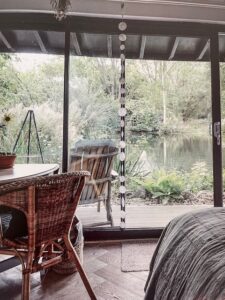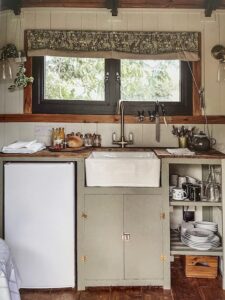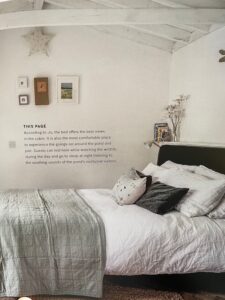Retreats for the Soul
Two of our spaces have been featured in a gorgeous new book published by Ryland Peters & Small. Featuring sustainable and stylish hideaways, Sara Bird and Dan Duchars (of The Contented Nest) reveal the essential elements of a soulful hideaway with stunning photography and practical tips to inspire you to create your own retreat using natural materials and vintage finds. Each of the 15 unique havens is accompanied by the story of their creation and I thought you might like to read some snippets from ours!
The book is available to browse (along with the others in the series: Homes for the Soul and Gardens for the Soul) while you’re here or you can purchase at all good bookshops.

Wildflower Wagon

Dragonfly Cabin

Journey’s End – Wildflower Wagon
“Time had not been kind to the old wagon, which stood in a paddock on the edge of the farmland that surrounds Jo and Tim’s family home. It had been there since the 1960s, when the local train line was decommissioned, and was used for many years as a shelter for orphan lambs.
With the help of a local restoration company, the old wagon was lifted out and taken away. Jo and Tim then spent three months clearing the area, sowing wildflower seeds, preparing the services and laying railway sleepers for the replacement carriage to sit on. They even built a new lamb shelter using reclaimed timber.
The ‘new’ wagon, supplied by the restoration company, is a similar vintage to the previous one: a 12-tonne covered fruit wagon from the 1930s, still with its original barrel-vaulted roof timbers and oak flooring. Jo loves to imagine all the things it has carried and the places it has been over the vears. With no concrete used in the installation process, the entire structure can be lifted away in the future and no one would know it had been there.
Jo’s family history has influenced the decoration just as much as the wagon’s own heritage. Her maternal grandfather William, who moved from Wales to London as a young man, worked for Great Western Railway’s catering department. Jo was born in London, but she and her mother spent their holidays in William’s home town of Tenby in Pembrokeshire and they later moved there when Jo was seven. As a result, she spent much of her youth travelling by train with the perk of free rail travel thanks to William’s job. The comfort and charm of carriage life made an enduring mark on her and she has furnished the wagon with an assortment of family owned vintage pieces that hark back to the period. The dark-wood furniture and vintage tablecloths of her childhood appear alongside found and reclaimed pieces from secondhand stores and jumble trails. Racks and overhead shelving made of reclaimed timber resemble the original neat luggage racks, while a king-size storage bunk from Ikea brings modern-day space-saving benefits to the sleeper-train setting.
Outdoors, visitors are encouraged to enjoy the peace and stillness, which is ironic considering the carriage’s previous life. There is a rocking chair nearby and a dining table is sited just outside with a firepit for evening warmth. Up in the adjoining woods is an alfresco bathtub and shower. Beneath the walnut tree with its station signage, a pair of hanging chairs looks out over the field. In dappled sunlight it is the perfect spot for quiet contemplation.
The Wildflower Wagon’s namesake blooms provide a steady season of change for pollinators and guests alike. With something new popping up each week, there is no need to venture far. The whole set-up looks back to the simpler times of Jo’s childhood and encourages winding down. The many railway trinkets and treasures rekindle cherished memories, allowing guests to embark on a new quieter and calmer journey into the past.”
Natural Tonic – Dragonfly Cabin
“Reimagining the crumbling structure and tackling the stagnant pond was not for the faint-hearted. However, Jo and Tim,, could see the benefits of having a nature reserve on their doorstep and were keen to embrace the joys of being in and around the water.
Beginning with the pond, the couple sought online help from natural pool expert David Pagan Butler. Following his advice, they cleared vast amounts of sludge and replaced it with gravel and sand. They then installed an air pump system and added lots of native water plants for filtration. Within eight months, the transformation was complete. With no need for cleaning chemicals, the pond is now brimming with waterlilies, newts and dragonflies, and is visited by all kinds of birds. A soothing swim among all this wildlife is a natural antidote to fast-paced modern living.
The second stage of the project was initiated by the collapse of the pondside hide during the pandemic. As lockdown kicked in and shortages of materials and labour took hold, building a new structure became a team effort for Jo, Tim and their teenagers. It gave them a connection to nature during a stressful period and a place to escape for some alone time when 24/7 family life at the main house became too much.
Jo paid particular attention to potential views from the cabin and even lay down on the dusty floor during the build to ensure that the bed would have the perfect pool vista. This view is now a firm favourite thanks to a huge picture window, which offers an expansive panorama of the natural elements from a place of safety.
This is an architectural principle known as ‘prospect-refuge’ – a similar technique was used by the American designer Frank Lloyd Wright, who was particularly well known for his organic architecture. Here, the water reflects light into the cabin as well as bringing in all the soothing sounds and colours of nature. No matter what the time or season, the water creates magical reflections across the whitewashed ceiling.
The idea to renovate the pond and create this waterside retreat was initially devised for the benefit of guests, but in reality it has become something of a salvation for all the family to enjoy. It is a place where they can swim outdoors whatever the season, absorb the benefits of being in nature and experience a habitual and harmonious exchange with the wild.”
